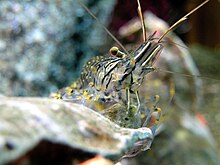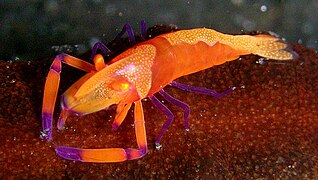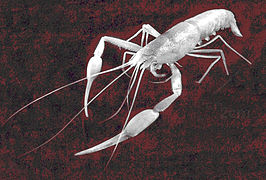| Palaemonoidea | |
|---|---|

| |
| Palaemon elegans (Palaemonidae) | |
| Scientific classification | |
| Domain: | Eukaryota |
| Kingdom: | Animalia |
| Phylum: | Arthropoda |
| Class: | Malacostraca |
| Order: | Decapoda |
| Suborder: | Pleocyemata |
| Infraorder: | Caridea |
| Superfamily: | Palaemonoidea Rafinesque, 1815 |
| Families | |
|
See text | |
Palaemonoidea is a large superfamily of shrimp, containing nearly 1,000 species.[1] The position of the family Typhlocarididae is unclear, although the monophyly of a group containing the remaining seven families is well supported.[2]
- Anchistioididae Borradaile, 1915
- Desmocarididae Borradaile, 1915
- Euryrhynchidae Holthuis, 1950
- Gnathophyllidae Dana, 1852
- Hymenoceridae Ortmann, 1890
- Kakaducarididae Bruce, 1993
- Palaemonidae Rafinesque, 1815
- Typhlocarididae Annandale & Kemp, 1913
-
Hymenocera picta, the only Hymenoceridae
See also[edit]
References[edit]
- ^ Sammy De Grave; N. Dean Pentcheff; Shane T. Ahyong; et al. (2009). "A classification of living and fossil genera of decapod crustaceans" (PDF). Raffles Bulletin of Zoology. Suppl. 21: 1–109.
- ^ Heather D. Bracken, Sammy De Grave & Darryl L. Felder (2009). "Phylogeny of the infraorder Caridea based on mitochondrial and nuclear genes (Crustacea: Decapoda)". In Joel W. Martin; Keith A. Crandall; Darryl L. Felder (eds.). Decapod Crustacean Phylogenetics. Crustacean issues. Vol. 18. CRC Press. pp. 281–305. ISBN 978-1-4200-9258-5.




Well, that’s interesting to know that Psilotum nudum are known as whisk ferns. Psilotum nudum is the commoner species of the two. While the P. flaccidum is a rare species and is found in the tropical islands. Both the species are usually epiphytic in habit and grow upon tree ferns. These species may also be terrestrial and grow in humus or in the crevices of the rocks.
View the detailed Guide of Psilotum nudum: Detailed Study Of Psilotum Nudum (Whisk Fern), Classification, Anatomy, Reproduction